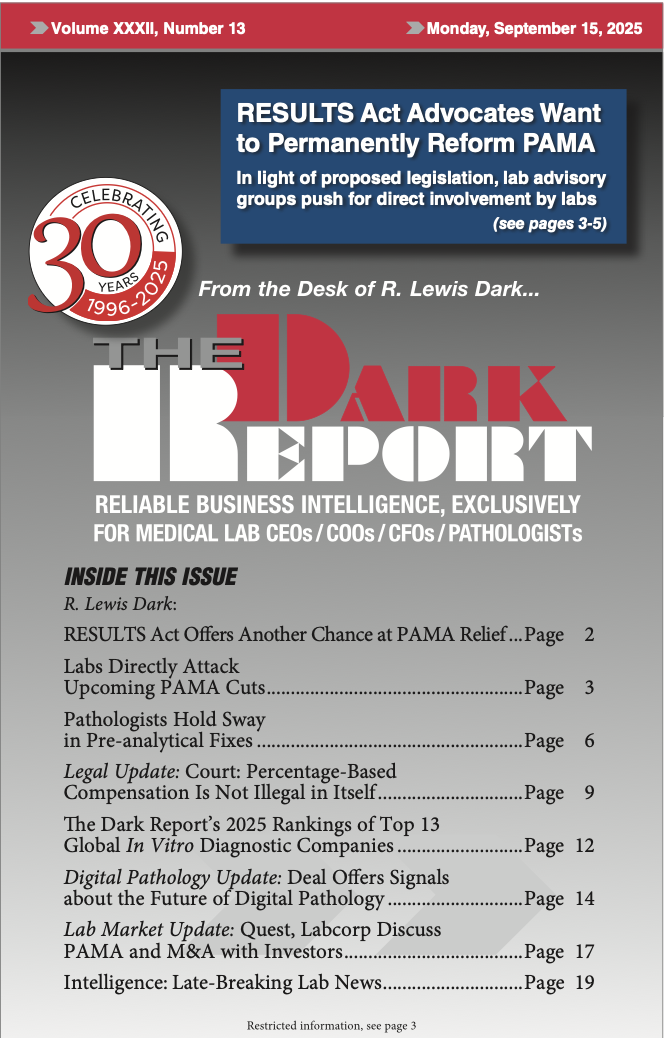Laboratory Management
Laboratory management in today’s clinical lab industry is changing rapidly and facing entirely new challenges. One problem is the lack of upcoming younger lab managers, as the retirements of baby boomer pathologists, medical technologists and lab scientists are in the near future. These individuals make up the largest proportion of supervisors, managers, and lab administrators working in labs today.
As they retire, every clinical lab and pathology group needs to have the next generation of leaders ready to step up and assume responsibilities. But, across the lab industry, there are limited opportunities for every lab’s brightest up-and-comers to get the regular management development opportunities that are common among Fortune 500 companies. The Dark Intelligence Group has called for the establishment of a mentoring program to help overcome this problem.
At the same time, downward pressure on reimbursements and mounting competition have created an environment that requires much more effort for a medical lab to grow and thrive.
Legislation, including the Health Information Technology for Economic and Clinical Health Act (HITECH) of 2009 and the Patient Protection and Affordable Care Act (PPACA) of 2010, have placed significant demands on medical laboratories and healthcare providers to improve internal efficiency even while offering more services for less money. This pressure to “do more with less” is further compounded by the need to deliver increasingly personalized client service to retain and win clients.
With the era of fee-for-service medicine coming to a close, every clinical laboratory and anatomic pathology organization needs a strategy for getting paid, as new reimbursement models that support patient-centric care will make up a larger portion of lab revenues.
The challenge for every clinical laboratory manager is to understand how to evolve from a business model that is accession-centric or volume-centric to one that is patient-centric.
Many clinical laboratories today are developing data repositories to logically link all transactional and other information about a patient. These repositories allow physicians to see all relevant information, identify trends, and provide better care as a result, enabling labs to provide greater value to their customers, patients and payers, thus creating more value and becoming more patient-centric.
Ex-NHL Executives Buy American Medical Labs
By Robert Michel | From the Volume V No. 6 – May 4, 1998 Issue
CEO SUMMARY: American Medical Laboratories’ sale to new owners is a major event. Not only does the new management team have a reputation for top performance in selling clinical laboratory services, but they also arrive with an ample war chest. When the revamped AML hits the competitive …
Regional Lab Systems Beginning To Emerge
By Robert Michel | From the Volume V No. 6 – May 4, 1998 Issue
CEO SUMMARY: Regionalization of laboratory services is about to become a dominant industry trend. Four groups of players will drive this process and each needs to recruit hospital laboratories to participate in their regional model. This is the first generation of attempts to create finan…
New Hybrid Lab Systems Provide Peek At Future
By Robert Michel | From the Volume V No. 6 – May 4, 1998 Issue
CEO SUMMARY: As the first generation of regional laboratory systems begin operation, the marketplace is about to separate winners from losers. Stakes are high for hospital laboratory administrators. If they choose to affiliate with the wrong model, the consequences can cause extended disr…
Partial List Of Regional Laboratory Networks
By Robert Michel | From the Volume V No. 6 – May 4, 1998 Issue
Public Laboratories Struggling To Maintain Competitive Ability
By Robert Michel | From the Volume V No. 6 – May 4, 1998 Issue
WITH regional laboratory systems as the theme of this issue, it is appropriate to look at the three national laboratories. What does 1997 and 1998 hold in store for them? For the last three years, news was uniformly bad for virtually every public laboratory. Problems at Corning Clinical Labo…
Where’s The Write-down ? LabCorp Faces Key Decision
By Robert Michel | From the Volume V No. 6 – May 4, 1998 Issue
CEO SUMMARY: Commercial laboratories are recognizing declines in the market value of their assets. LabCorp has yet to do the same. Taken cumulatively, these write-downs demonstrate the sizable revenue erosion that large commercial laboratories experienced during the past three years. Soon…
LabCorp Struggling To Regain Financial, Operational Balance
By Robert Michel | From the Volume V No. 6 – May 4, 1998 Issue
CEO SUMMARY: 1997 will be a “make or break” year for Laboratory Corporation of America. The company is challenged on many fronts. As LabCorp’s management focuses on internal issues, nimble laboratory competitors have an opportunity to capture additional market share. …
Cigna Buys HealthSource, Inc., Increases Managed Care Clout
By Robert Michel | From the Volume V No. 6 – May 4, 1998 Issue
CEO SUMMARY: Consolidation continues among managed care companies. Cigna’s acquisition is an effort to boost its managed care business. Healthsource’s market coverage complements areas where Cigna can use the additional market strength to negotiate more favorable contracts with provid…
LabCorp Seeks $500 Million Through Public Stock Offering
By Robert Michel | From the Volume V No. 6 – May 4, 1998 Issue
CEO SUMMARY: After a financially difficult year in 1996, LabCorp enters 1997 with plans to raise $500 million. Despite the laboratory industry’s poor prospects, LabCorp will probably succeed in raising capital. After this infusion of capital, will LabCorp’s new management team have wi…
AmeriPath To Go Public, Files SEC Registration
By Robert Michel | From the Volume V No. 6 – May 4, 1998 Issue
CEO SUMMARY: AmeriPath’s Initial Public Offering will make it the first publicly traded physician practice management company specializing in pathology. It represents a unique attempt to restructure traditional pathology practices to meet the needs of managed healthcare organizations….
CURRENT ISSUE

Volume XXXII, No. 13 – September 15, 2025
The Dark Report examines a new bill that would reform PAMA and avoid reimbursement rate cuts scheduled for January 2026. Clinical laboratory leaders are urged to make their voices heard in Congress. Also, an expert describes how labs can fix pre-analytical errors and avoid disaster.
See the full table of contentsHow Much Laboratory Business Intelligence Have You Missed?
Lab leaders rely on THE DARK REPORT for actionable intelligence on important developments in the business of laboratory testing. Maximize the money you make-and the money you keep! Best of all, it is released every three weeks!
Sign up for TDR Insider
Join the Dark Intelligence Group FREE and get TDR Insider FREE!
Never miss a single update on the issues that matter to you and your business.
Topics
- Anatomic Pathology
- Clinical Chemistry
- Clinical Laboratory
- Clinical Laboratory Trends
- Digital Pathology
- Genetic Testing
- In Vitro Diagnostics
- IVD/Lab Informatics
- Lab Intelligence
- Lab Marketplace
- Lab Risk & Compliance
- Laboratory Automation
- Laboratory Billing
- Laboratory Compliance
- Laboratory Equipment
- Laboratory Information Systems
- Laboratory Management
- Lean Six Sigma
- Managed Care Contracts
- Molecular Diagnostics
- Pathology Trends
- People
- Uncategorized

